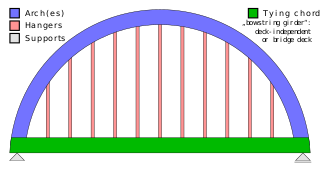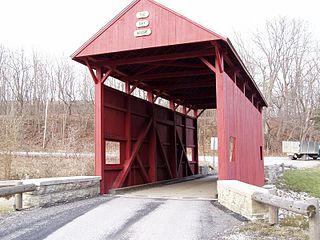
A truss is an assembly of members such as beams, connected by nodes, that creates a rigid structure.

A truss bridge is a bridge whose load-bearing superstructure is composed of a truss, a structure of connected elements, usually forming triangular units. The connected elements, typically straight, may be stressed from tension, compression, or sometimes both in response to dynamic loads. There are several types of truss bridges, including some with simple designs that were among the first bridges designed in the 19th and early 20th centuries. A truss bridge is economical to construct primarily because it uses materials efficiently.

The Ashtabula River railroad disaster was the failure of a bridge over the Ashtabula River near the town of Ashtabula, Ohio, in the United States on December 29, 1876. A Lake Shore and Michigan Southern Railway train, the Pacific Express, passed over the bridge as it failed. All but the lead locomotive plunged into the river. The train's oil lanterns and coal-fired heating stoves set the wooden cars alight. Firefighters declined to extinguish the flames, leaving individuals to try to pull survivors from the wreck. Many who survived the crash burned to death in the wreckage. The accident killed approximately 92 of the 160 people aboard. It was the worst rail accident in the U.S. in the 19th century and the worst rail accident in U.S. history until the Great Train Wreck of 1918.

A lattice truss bridge is a form of truss bridge that uses many small, closely spaced diagonal elements forming a lattice. The design was patented in 1820 by architect Ithiel Town.

Framing, in construction, is the fitting together of pieces to give a structure support and shape. Framing materials are usually wood, engineered wood, or structural steel. The alternative to framed construction is generally called mass wall construction, where horizontal layers of stacked materials such as log building, masonry, rammed earth, adobe, etc. are used without framing.

A tied-arch bridge is an arch bridge in which the outward horizontal forces of the arch(es) caused by tension at the arch ends to a foundation are countered by equal tension of its own gravity plus any element of the total deck structure such great arch(es) support. The arch(es) have strengthened chord(s) that run to a strong part of the deck structure or to independent tie-rods below the arch ends.

In mechanical engineering, stressed skin is a rigid construction in which the skin or covering takes a portion of the structural load, intermediate between monocoque, in which the skin assumes all or most of the load, and a rigid frame, which has a non-loaded covering. Typically, the main frame has a rectangular structure and is triangulated by the covering; a stressed skin structure has localized compression-taking elements and distributed tension-taking elements (skin).

The Ada Covered Bridge is a 125-foot (38 m) span Brown truss covered bridge erected in 1867 in Ada, Michigan, United States. Carrying Bronson Street across the Thornapple River, it is located just south of where the Thornapple enters the Grand River, in turn just south of M-21. It is listed on the National Register of Historic Places.

Whites Bridge is a 120-foot-long (37 m) Brown truss covered bridge, originally erected in 1869 in Keene Township, Michigan, United States, near Smyrna on the Flat River. Carrying Whites Bridge Road across the Flat River, it is located north of the Fallasburg Bridge and south of Smyrna. The original bridge was among the area's best-known 19th century structures. The bridge was completely destroyed by fire, on the morning of July 7, 2013. In July 2016, approval was granted for rebuilding a replica bridge, which was completed in April 2020.

Fallasburg Bridge is a 100-foot (30 m) span Brown truss covered bridge, erected in 1871 in Vergennes Township, Michigan, United States, 5 miles (8.0 km) north of Lowell on the Flat River. Carrying Covered Bridge Road across the Flat, it is located in the Fallasburg Historical District south of Whites Bridge and Smyrna. It is listed on the National Register of Historic Places, and along with Whites Bridge, Langley Covered Bridge, and Zehnder's Holz Brucke, is one of only four Michigan covered bridges open to vehicle traffic.

A Howe truss is a truss bridge consisting of chords, verticals, and diagonals whose vertical members are in tension and whose diagonal members are in compression. The Howe truss was invented by William Howe in 1840, and was widely used as a bridge in the mid to late 1800s.

A king post is a central vertical post used in architectural or bridge designs, working in tension to support a beam below from a truss apex above.

A queen post is a tension member in a truss that can span longer openings than a king post truss. A king post uses one central supporting post, whereas the queen post truss uses two. Even though it is a tension member, rather than a compression member, they are commonly still called a post. A queen post is often confused with a queen strut, one of two compression members in roof framing which do not form a truss in the engineering sense.

The Cornish–Windsor Covered Bridge is a 157-year-old, two-span, timber Town lattice-truss, interstate, covered bridge that crosses the Connecticut River between Cornish, New Hampshire, and Windsor, Vermont. Until 2008, when the Smolen–Gulf Bridge opened in Ohio, it had been the longest covered bridge in the United States.

Rexleigh Bridge is a wooden covered bridge over the Batten Kill in Washington County, New York. It is one of 29 historic covered bridges in New York State.

The Grant Mills Bridge, officially the Millbrook Bridge, is a wooden covered bridge over Mill Brook in Hardenburgh, New York, United States. It is one of 29 covered bridges in the state.

A timber roof truss is a structural framework of timbers designed to bridge the space above a room and to provide support for a roof. Trusses usually occur at regular intervals, linked by longitudinal timbers such as purlins. The space between each truss is known as a bay.

The Hadley Parabolic Bridge, often referred to locally as the Hadley Bow Bridge, carries Corinth Road across the Sacandaga River in Hadley, New York, United States. It is an iron bridge dating from the late 19th century.

The bridge is significant locally as the only Pratt through-truss bridge remaining in Kosciusko County, and is important regionally as one of the few surviving spans built by the Bellefontaine Bridge and Iron Company.
The Fink truss is a commonly used truss in residential homes and bridge architecture. It originated as a bridge truss although its current use in bridges is rare.


























